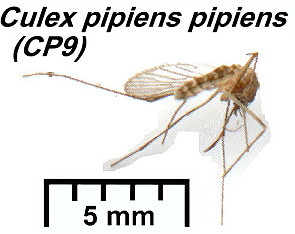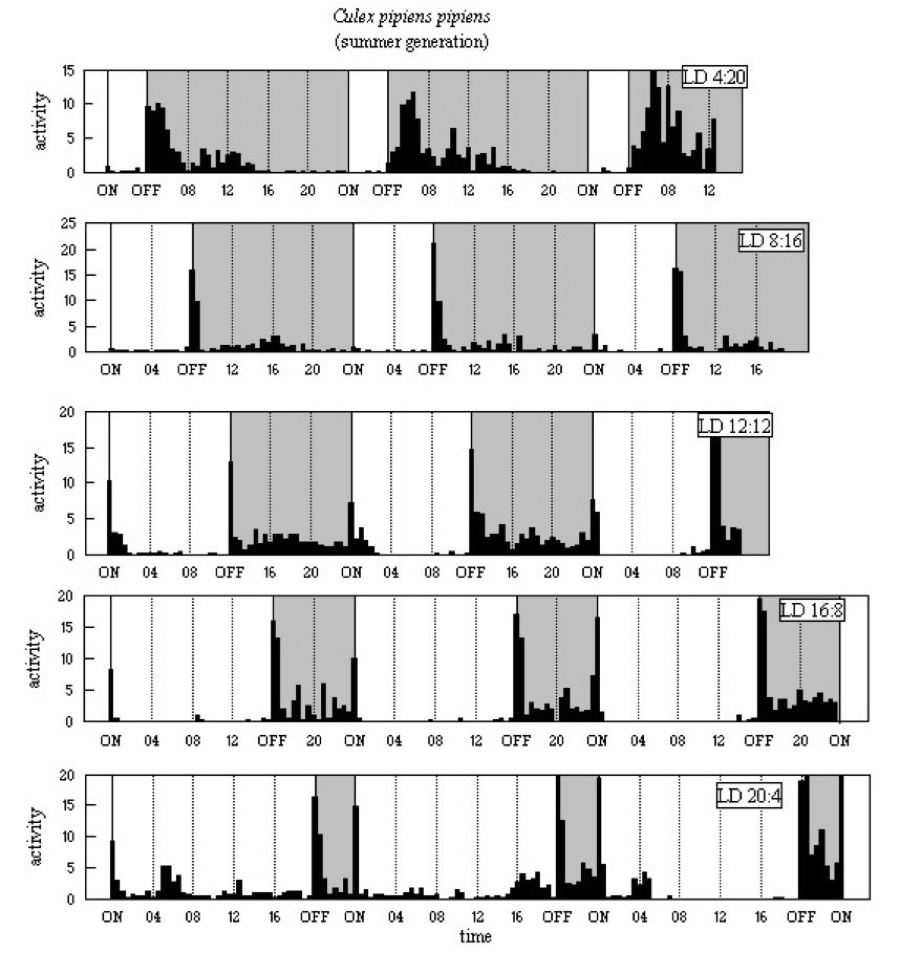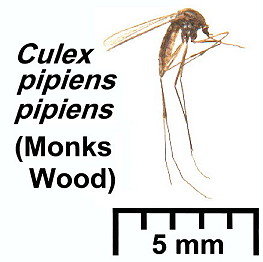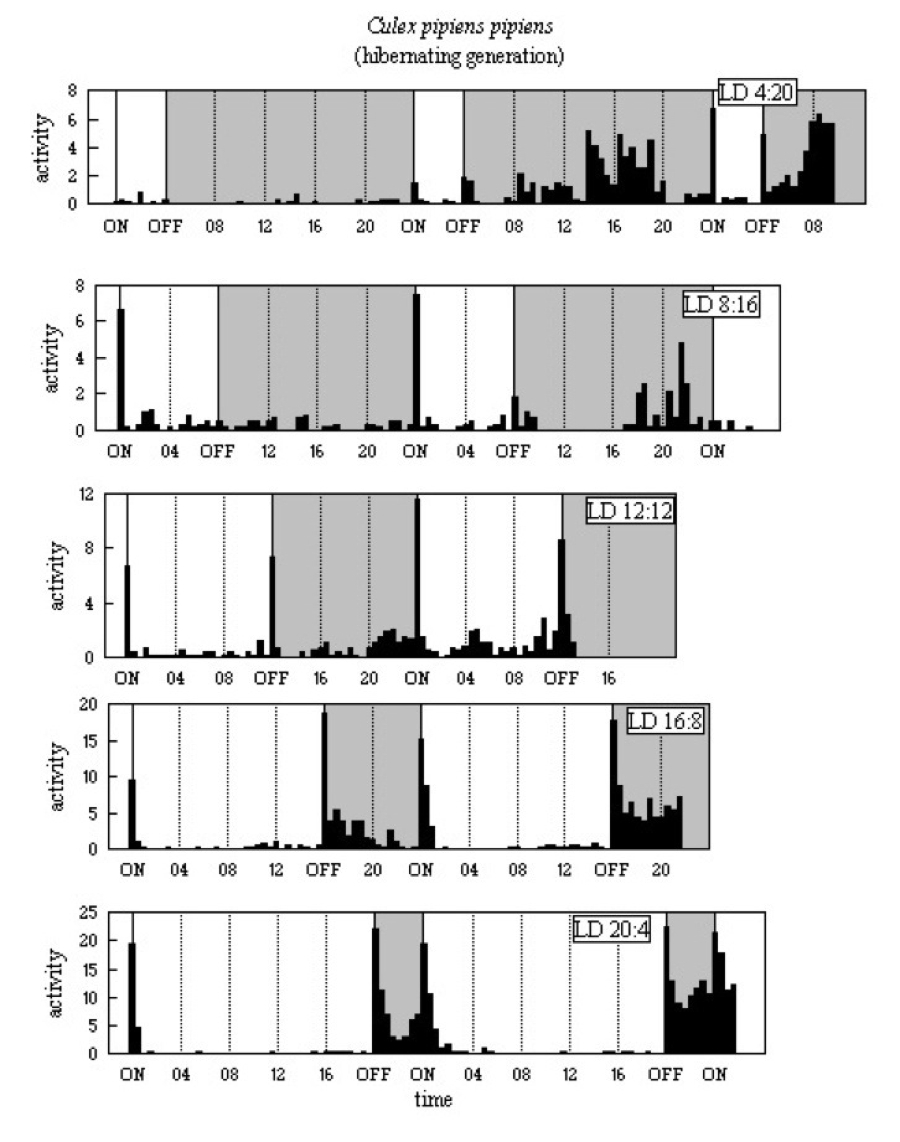Biological Clocks in Mosquitoes
|
Stone et al. (1959) list the substantive species Culex (Culex) pipiens Linnaeus, as being primarily Holarctic in its distribution but with populations in eastern and southern Africa and in southern South America. The type locality is Lapponia, Europe. Natvig (1948) gave a northern limit of 63°N in Norway. The range in North America is from 30°N to 60°N (Carpenter & La Casse, 1955). In Holarctic areas the adults are active during the summer months, April to November (Marshall, 1938) but hibernate during the winter in man-made shelters (Tate & Vincent, 1936; Service, 1968). Females which emerge in the Autumn are not attracted to their normal avian hosts but feed on plant juices. They lay down large reserves of fat and glycogen before entering hibernation, not taking a bloodmeal until the following Spring. Snow (1990) described how the first egg rafts are laid in early April and develop to give adults from May onwards. This Summer generation does not survive beyond late Autumn.

Experimental material
Adult females were reared from larvae collected from a garden pond at
Richmond, Surrey, England (51°28'N). The first group were reared in
natural daylight from 10 July 1968 (sunrise 0506h and sunset 2106h BST,
daylength 16h) and the second group were similarly reared from 3 August
1968 (sunrise 0527h and sunset 2045 BST, daylength 15h18m). Recordings
were made with light-off at 2100h BST (July).
Experimental regimes
LD 4:20, six females, recorded for days two to five, first group.
LD 8:16, five females and one male, recorded for days two to
five, second group.
LD 12:12, five females and one male, recorded for days three to
five, second group.
LD 16:8, six females, recorded for days two to five, first group.
LD 20:4, six females, recorded for days two to five, first group.
Results. The activity patterns are shown in Figure A10 below. In all five LD regimes there is a major E peak, with moderate activity throughout the night. The E peak is more diffuse and somewhat late in LD 4:20, there is some pre-light-off activity in LD 20:4. M peaks are clear at light-on in the three long L regimes; and diffuse peaks occur some 8-10h after light-off in LD 4:20, LD 8:16 and LD 20:4. The last is the only regime in which significant activity occurs in the light.
Figure A10


Experimental material
The adults were collected at Monk's Wood Experimental Station,
Huntingdonshire, England (latitude 52°24'N) on 28 January 1969 (January
daylength about 8h30m).
Experimental regimes
LD 8:16 to LD 4:20, six females. Recorded in LD 8:16 for days
three to five then light-on delayed 4h to give LD 4:20 until day nine.
LD 12:12 to LD 16:8, six females. Recorded in LD 12:12 for days
three to five then light-on advanced 4h to give LD 16:8 until day eight.
LD 20:4, six females. Recorded for days five to eight.
Results
The activity patterns are shown in Figure A11 below. The activity in
the two short L regimes is markedly less than when
L > 12h, and overall activity clearly increases as L
becomes longer. In LD 4:20, which followed LD 8:16, the activity
almost ceased for the first two 24h cycles; these mosquitoes showed M
activity which was greater than E. When L = 12h or longer,
similar levels of E and M activity formed a clear
bimodal pattern.
Figure A11

The most obvious difference between the Summer and Hibernating generations is that in short L regimes the latter are less active but have a more marked M. Lewis & Taylor (1965) and Service (1971), using suction traps in England, found Cx. p. pipiens (unfed females, with marked fat reserves) to be bimodally active, with a small morning peak at around 0500h and much more activity between 1700h and 2000h, with most activity at 1800-1900h. The sunrise and sunset times during the overall period of Service's studies were between 0342-0501h and 1902-2019h respectively. These long-day results are comparable with the laboratory results for the Summer generation (see Figure A10).
The phenomenon of hibernation was investigated by Tate & Vincent (1936), who found man-biting races, described as autogenous, and, non-man-biting races, described as anautogenous. In modern terms, it seems probable that the autogenous race actually was Cx. p. molestus and the anautogenous race was Cx. p. pipiens. Most of their research was on the latter and they found that the hibernating generation could be activated out of season by exposure to long days or continuous light. Laboratory cultures maintained in long days would breed all year round. Thus, they suggested that length of daylight could be a factor of importance in controlling hibernation.
|
©1998, 2010 - Brian Taylor CBiol FSB FRES 11, Grazingfield, Wilford, Nottingham, NG11 7FN, U.K. Comments to dr.b.taylor@ntlworld.com |
href="\crhtml\cxpp.htm"